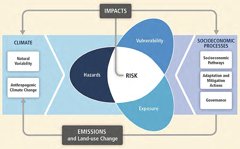 This week’s Daily Blog post takes a further look at NZ political responses to the release of the of the second part of the IPCC’s Fifth Report, and ponders how everyone who has gleefully claimed that adaptation is all we need to do will react when the third report — on mitigating carbon emissions — is released next week. Good risk management would mean planning to adapt to four degrees of warming, while aiming at emissions reductions that would restrict warming to two degrees…
This week’s Daily Blog post takes a further look at NZ political responses to the release of the of the second part of the IPCC’s Fifth Report, and ponders how everyone who has gleefully claimed that adaptation is all we need to do will react when the third report — on mitigating carbon emissions — is released next week. Good risk management would mean planning to adapt to four degrees of warming, while aiming at emissions reductions that would restrict warming to two degrees…
Tag: AR5
IPCC WG2 impacts report released: fire, floods and rising seas in all our futures
 After the usual run of late nights and argument, the IPCC has released the second part of its fifth report — the Working Group 2 report on climate impacts and risks management. Commenting on the report, VUW climate scientist Professor Tim Naish said “this latest report makes it quite clear that New Zealand is under-prepared and faces a significant ‘adaptation deficit’ in the context of the projected impacts and risks from global average warming of +2 to 4°C by the end of the century.”
After the usual run of late nights and argument, the IPCC has released the second part of its fifth report — the Working Group 2 report on climate impacts and risks management. Commenting on the report, VUW climate scientist Professor Tim Naish said “this latest report makes it quite clear that New Zealand is under-prepared and faces a significant ‘adaptation deficit’ in the context of the projected impacts and risks from global average warming of +2 to 4°C by the end of the century.”
The IPCC identifies eight key regional risks for New Zealand and Australia:
- significant impacts on coral reefs in Australia as oceans warm and acidify
- loss of montane ecosystems in Australia, as climate warms and snow lines rise
- increased frequency of and intensity of flooding in NZ and Australia
- water resources in Southern Australia will be under increased pressure
- more intense heatwaves will bring increased death rates and infrastructure damage
- increasing risks of damaging wildfires in New Zealand and southern Australia
- increased risks to coastal infrastructure and ecosystems from sea level rise
- risk of severe drying in parts of Australia could hit agricultural production
For New Zealand, extreme weather events such as flooding and heatwaves are expected to increase in frequency and severity, and rainfall is expected to increase on the already wet west coast and decrease in the east and north east. Sea level rise of up to one metre is expected to cause significant problems for coastal communities.
VUW’s Jim Renwick points to sea level rise as a big issue:
Every 10cm of rise triples the risk of a given inundation event, and we are expecting something like a metre of rise this century. That would mean today’s 1-in-100 year event occurs at least annually at many New Zealand coastal locations. New Zealand has a great deal of valuable property and infrastructure close to the coast that will be increasingly at risk as time goes on.
The Summary for Policymakers of the WG2 report is available here (pdf), and the final draft of the full report can be downloaded from this page. The Australia and New Zealand chapter (25) is here (pdf) and the Small Islands (Ch 29) here (pdf).
A huge amount of coverage of the report’s findings has already hit the net, and there will be more to come. Check out The Guardian‘s take on the five key points in the report, The Conversation’s examination of climate health risks, Graham Readfearn’s commentary on 25 years of IPCC warnings, and Peter Griffin’s look at the prospects for agriculture. I’ll have a post about the NZ political response to the report tomorrow.
Saturday snark: a textbook for Vincent
 As Stoat points out, the IPCC has released the reviewers comments on the Working Group One second order draft report. And as you might expect, the IPCC’s favourite inexpert commenter, the New Zealand Climate “Science” Coalition’s very own Vincent Gray was busy reviewing their work. Here’s comment 1-549 from Chapter One (pdf) by Gray:
As Stoat points out, the IPCC has released the reviewers comments on the Working Group One second order draft report. And as you might expect, the IPCC’s favourite inexpert commenter, the New Zealand Climate “Science” Coalition’s very own Vincent Gray was busy reviewing their work. Here’s comment 1-549 from Chapter One (pdf) by Gray:
The records shown are not “observations” and they are not “temperatures”. They are also not “globally averaged. They are a set of multiple averages, subtracted from an overall average, compiled from a vaying non-standardised set of maximum an minimum temperature measurements at varying weather sations and ship measurements. They were previously treated as “Mean Global Temperature anomaly” The uncertainties attached to each figure are very great, individual temperature measurements are rarely accurate to better than one degree, so a claimed “trend” over 100 years of less than one degree has a very low level of statistical significance. [Vincent Gray, New Zealand] (all spelling from IPCC doc)
The response from the editors is a minor classic of its kind:
Rejected – The comment does not reflect the scientific understanding. The errors in individual observations are not additive; we are also doing relative analysis that eliminates many of the concerns about individual errors. The reviewer obviously has a limited understanding of the associated error evaluation for analysis of large datasets. See Chapter 2 for more on the evaluation of these datasets. Or maybe even read a basic textbook. (my emphasis)
For more on accuracy versus precision, and the statistical power of large numbers, this classic post by Tamino is well worth a read.
There are other minor gems to be found as the reviewers deal with Monckton (in the “general” section) and John McLean (seemingly everywhere). In fact McLean’s ubiquity suggests that he may have acceded to Gray’s throne as the man with most comments on a single IPCC report. But don’t expect me to add them all up, I do have a life…
People talkin’ about science (and water)
[youtube http://www.youtube.com/watch?v=6yiTZm0y1YA&w=480]
To kick off a new open thread (biofarmer, that’s you I’m looking at), here’s the IPCC’s new/latest video, in which various lead authors and Working Group 1 luminaries talk about the state of our understanding of the physical science of climate. You may also wish to discuss — anything. Have at it…
TDB Today: The Inconvenient Neighbours
 Over at The Daily Blog today, in a post headlined The Inconvenient Neighbours, I consider the case of the Kiribati man who is claiming refugee status in New Zealand because of the impact of sea level rise on his home island. With the IPCC report suggesting that sea level could rise by as much as a metre this century, it’s surely a sign of things to come…
Over at The Daily Blog today, in a post headlined The Inconvenient Neighbours, I consider the case of the Kiribati man who is claiming refugee status in New Zealand because of the impact of sea level rise on his home island. With the IPCC report suggesting that sea level could rise by as much as a metre this century, it’s surely a sign of things to come…
